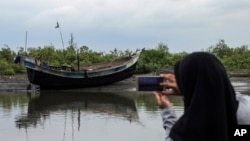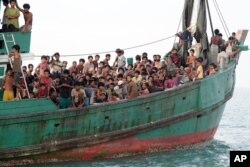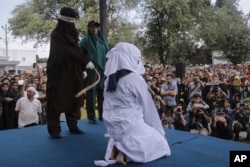Two boats carrying Rohingya refugees from Myanmar’s Rakhine State have landed in Indonesia’s westernmost province of Aceh, evidence of the ongoing exodus of what has been called the world’s most persecuted minority. Due to Aceh’s location, at the tip of Sumatra island and across the Andaman Sea from Myanmar, the province has received nine different sets of seaborne Rohingya refugees within the last decade.
“There’s a big difference now, in 2018,” said Mariam Khokhar, who heads the Medan office of the International Organization for Migration, which has provided humanitarian assistance to all nine instances of Rohingya arrivals in Aceh. “They used to get access to bigger boats, but now there great desperation and the Rohingya are using smaller boats to get out.”
Aceh is now something of an old hand with Rohingya arrivals, even though Indonesia is not a signatory to the 1951 Refugee Convention and does not formally recognize or assist refugees on a national level. In 2015, Acehnese people, who are among the most conservative Muslims in all of Indonesia, made headlines for their warm embrace of their fellow Muslim Rohingya refugees.
This month, the IOM is working with the Aceh local government to house and assist the 84 new Rohingya arrivals.
“The vice governor of Aceh who said if they come to Aceh we will assist them, we believe in the dignity of people and things like that. So indeed the local govenment and the local people have been amazing,” said Khokhar.
Rohingya in Indonesia
The Rohingya are an ethnic Muslim group in Buddhist-majority Myanmar. The Rohingya refugee crisis peaked in 2016 when an offensive strike by a Rohingya militant group led to a brutal crackdown by the Myanmar military. Over 600,000 people have fled Rakhine state, most of them crossing the land border on foot to Bangladesh.
Those who choose to leave on boats often head for Malaysia, where refugees can find work as laborers.
All the seaborne arrivals in Indonesia have occurred between January and May, when the seas are calm enough to support the journey.
“That's a total of about 1,750 people. The structures are in place for local government to respond to these and for us to assist if we are called upon to do so,” said Paul Dillon, a project manager at IOM Indonesia. In contrast, there are an estimated 90,000-100,000 Rohingya refugees currently in Malaysia.
"So when things have been relatively stable in the Rakhine the departures tend to go down," said Dillon, whereas they rise when there is instability. "This is a feature of forced migration everywhere on the planet...All of the [recent] movements of people were preceded by periods of instability in the Rakhine state." (slightly condensed the quotes here)
Khokhar said that sixty-six percent of the most recent arrivals are categorized as "vulnerable," which means they are unaccompanied minors, single mothers, or single females.
Long-term solution remains elusive
Aceh’s social services office works with the IOM to provide humanitarian relief.
They were first housed in a government facility in Bireuen Regency and are now being moved to a more permanent camp in Langsa. They are not being encouraged to continue on to Malaysia, although Khokhar said a few will likely try to go anyway.
The IOM has also helped previous Rohingya arrivals in Aceh to voluntarily return to Bangladesh or to be processed for resettlement in Western countries, including the United States.
Aceh is the only Indonesian province to have full sharia, or Islamic law, and implementation there includes public floggings and vigilante moral police. The Acehnese people have always been uniquely conservative and they fought for decades to be their own state, separate from Indonesia, only giving up when the province was devastated by the 2004 Boxing Day tsunami. Aceh was proverbially the first place in the Malay archipelago to have residents become Muslims, when Muslim traders came to Sumatra as early as the 13th century.
Perhaps because of their strong Muslim identity, the Acehnese have, for several years now, been uniquely hospitable to Rohingya refugees. At the forefront are the local fishermen who rescue them from boats.
“The Acehnese adat [customary law] is very strong and obliges fishermen to save any life that is at risk at sea. These were the principles used by Acehnese fisherman to say we can stand up against national law cause our law is higher,” explained Lilliane Fan, of the nonprofit Geutanyoe Foundation, in 2015.
Of course, the 84 new refugees in Aceh are a minuscule fraction of the hundreds of thousands of refugees worldwide. “The 650,000 Rohingya in Bangladesh are the elephant in the room,” said Dillon.
“Rohingya are internationally recognized as a persecuted group so their pathway to recognition as refugees is easier, but their resettlement chances are the same as every other refugee,” said Trish Cameron, a refugee lawyer based in Jakarta. Which is to say, not very high at all.












